
 |
Tea Clipper |
 |
| from TeaAntiques.com | ||
| Edition Fifty Five |
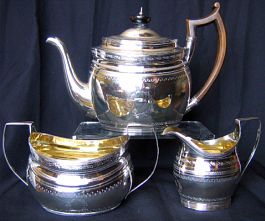
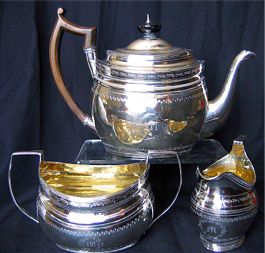
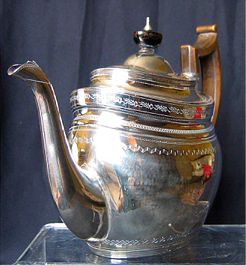
A magnificent and stunningly beautiful George III Sterling silver three piece teaset 1801/1807. This beautiful teaset is of an oval shape with exquisite 'bright-cut' decoration and is extremely fine condition. The milk jug and sugar basin of this set have gilded interiors, making this an extra special and very high quality tea service.
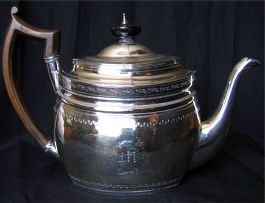
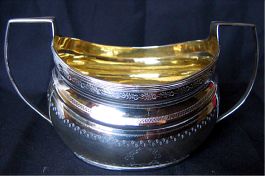
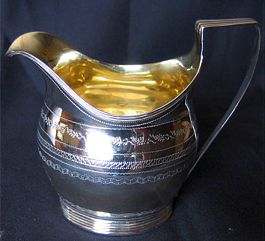
This teaset has been part of my own private collection of Georgian silver and I have used it on some formal occasions. Therefore, I can say that it is a beautiful teaset to use and has been greatly admired by my tea time guests.
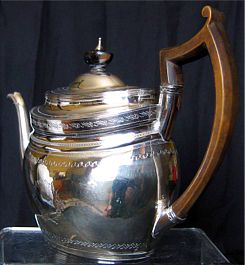
All three pieces have been made by the same maker, whom I believe is probably George Baskerville, a renowned maker of fine tea services from the late eighteenth century, particularly of bright cut neo-classical designs, such as this teaset. Although made by the same maker and all of exactly the same design, the teapot and milk jug are dated 1801, whereas, the sugar basin is dated 1807. This may just be that the teapot and jug were made at this earlier date, but when sold, the original purchaser requested a sugar basin to go with the set which was made about six years later. There is certainly no question that they are all the same original set.
The teapot, sugar basin and milk jug are each clearly hallmarked.
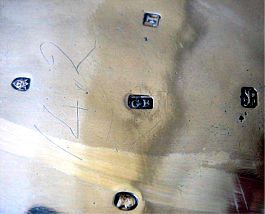


A wonderful George III Sterling Silver three piece teaset for the connoisseur collector of eighteenth century English silver or the lover of tea wares.
More details of this item and other tea related antiques can be found by visiting my web site at www.TeaAntiques.com.
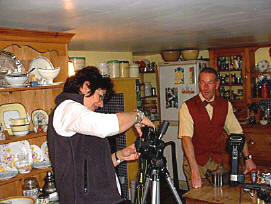
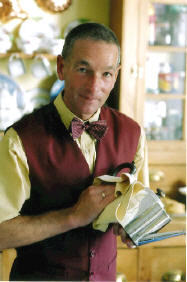 Nearly
two years ago, I was asked if I could do an article for the BBC magazine 'Homes
and Antiques' on the cleaning of antique silver, in particular a Georgian silver
teapot. The article I am informed, will be in the July 2005 issue of this
magazine, so for those of you who take this magazine, keep an eye out for me
there. The work in preparation of the article took the best part of a day and
was great fun. Francene Lawrence, the photographer and Barty Philips, the
journalist, were wonderful to work with and I hope that from the day an
interesting little feature will be included in the magazine.
Nearly
two years ago, I was asked if I could do an article for the BBC magazine 'Homes
and Antiques' on the cleaning of antique silver, in particular a Georgian silver
teapot. The article I am informed, will be in the July 2005 issue of this
magazine, so for those of you who take this magazine, keep an eye out for me
there. The work in preparation of the article took the best part of a day and
was great fun. Francene Lawrence, the photographer and Barty Philips, the
journalist, were wonderful to work with and I hope that from the day an
interesting little feature will be included in the magazine.
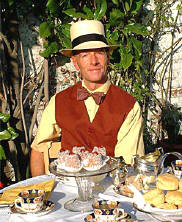 After
spending many hours being photographed and interviewed, the day was rounded off
with an afternoon tea I had prepared for them in the garden, a nice way to relax
after the busy day. As the autumn sunshine shone, we enjoyed sandwiches, scones,
clotted cream and home made jam, followed by Madeleine cakes, which went down a
treat. A dainty Edwardian china teaset and a beautiful Georgian silver teaset,
(the one that is my Featured Antique), completed an elegant afternoon tea
setting.
After
spending many hours being photographed and interviewed, the day was rounded off
with an afternoon tea I had prepared for them in the garden, a nice way to relax
after the busy day. As the autumn sunshine shone, we enjoyed sandwiches, scones,
clotted cream and home made jam, followed by Madeleine cakes, which went down a
treat. A dainty Edwardian china teaset and a beautiful Georgian silver teaset,
(the one that is my Featured Antique), completed an elegant afternoon tea
setting.
If you manage to see a copy of the magazine when it is published, I hope that you enjoy the article and even find it is of use in the cleaning of your faithful antique silver.
An amazing architectural treasure lies on the West side of London, at
Chiswick, Chiswick House. This unusual 'Palladio' style miniature mansion was the
work of the inspired young Lord Burlington (1694-1753). At the age of 20, Lord
Burlington went away on the Grand Tour of Europe to improve his education and
appreciation of the arts. His tour would take him on the usual route through
Germany, South to Italy. In Italy, he would visit the architecturally rich cities
such as Rome and like others on their Grand Tour would buy and ship home fine
works of art, paintings, sculptures and furniture with which to fill their
houses at home in England.
It was not in his initial Grand Tour that the 3rd Lord Burlington
became interested in the building works of Andrea Palladio, but in a subsequent
journey back to Italy at the age of 25. In this second journey he was there
studying the buildings designed by the sixteenth century Palladio, particularly
the classical villas built for the wealthy Italians of the period. From his
studies, he returned to England inspired to create a Palladio style villa in the
rural retreat of Chiswick. the house was built sometime between 1727-29.
The Burlington family already had a country house at Chiswick as well as their town house in the centre of London, Burlington House, Piccadilly. It was his idea to build a villa taking the designs from Palladio's villas and combining them with the designs of Inigo Jones, architect in the time of James I. He thus designed a villa, small in scale, but exuberant in its architectural detail. It followed Palladio's principle of having a rusticated ground floor above which was the piano noble, or grand apartments, build round a central saloon open to a dome in the centre of the building. These two men, Andrea Palladio and Inigo Jones, who inspired the design of the house now stand as statues flanking the front of the house. Inigo Jones on the right and Andrea Palladio to the left.
The house was designed not so much as a house in which to live, but a place
where he could entertain his friends, particularly in the process of
patronising the arts. It also provided a suitable place in which to house the
treasures that he had brought back from his Grand Tour. Thus Chiswick House
that we see today was designed and stood adjacent to the older family home and
connected by a 'link' building. The 'Link building remains, but the old house is
no longer standing.
This new Chiswick House was once scathingly described at the
time by one person as 'too small to live in and too large to hang one's
pocket watch'. despite such comments it was to become a place to which
people would flock to see this latest in house design and could gain entry for a
small fee.
Lord Burlington was not only an avid collector of paintings, sculptures and other fine works, he was keen on promoting other talents in the music and art world. He was patron to such famous people as George Frederick Handle, who would often perform for Lord Burlington.
Today, the house and grounds are administered by English Heritage and thus
remain open to the public. It remains an outstanding architectural gem that is
worth studying from the outside before taking a tour of the interior.
The exterior shows a two storey building with the first floor richly
ornamented, whilst the ground floor has a plain and simple finish denoting its
domestic function. For those fortunate guests to gain access into the first
floor rooms, there is a staircase at the entrance side of the house. This
elaborately designed staircase has two flights of steps to the first floor, the
lower section of the steps on each side are sub-divided into two further
staircases thus creating an even more imposing entrance. The staircase leads up
to the portico from which access into the central octagonal saloon can be
gained. The triangular pediment of the portico is supported by Corinthian
columns, these taken from illustrations by Palladio of an ancient Roman Temple
in Naples. The capitals of the columns crisply carved with the floral design
which is said emulates from a wicker basket which having been rested on the
ground, flora has grown up through it and sprouting out of the
basket weave. In
the house, this has been cleverly illustrated in the plasterwork in one of the
octagonal rooms where a gilded lady's head carries such a basket with leaves
sprouting forth from the top.
The frieze, on which the base of the first floor sits, is exuberantly carved
with crisp decoration, which includes 'egg and dart' at the lower level. There
are 'Venetian' tripartite windows on either side of the house. The chimneys,
which are tapering in shape, are very unusual in English architecture and were
derived from the Obelisk shapes. Obelisks, although ancient Egyptian in origin,
would have been familiar sights in Rome too.
The dome in the centre of the house is modelled on the ancient Roman
Parthenon in Rome. It has semicircular windows high up in the central
saloon allowing light in but without losing wall space. Such windows were often
used in ancient Roman bath houses.
Entering the house through the central door in the ground floor, the visitor is led through into a small room in which is a film presentation giving some background information of the house and Lord Burlington.
Passing though a short corridor it leads you into the central octagonal hall, known as the Lower Tribune Hall and is directly below the grand saloon above, known as the Tribunal saloon. The rooms that surround the lower Tribune are mainly set out with display boards offering more information about the house's history.
Access to the first floor and its principle rooms is by a very modest spiral
stone staircase. This is one of three such staircases and would have been used
by Lord Burlington and his guests on all but ceremonial occasions. Taking this
staircase leads up to one end of the Gallery, which is actually formed of three
rooms along the north side (or back) of the house. These three rooms are open to
each other through archways. The end Gallery, to which the staircase leads, is
circular in form, with curved fireplace and ornamentation including an elaborate
frieze around the ceiling. Opposite the fireplace is the open arch which leads
through to the central portion of the Gallery.
This central rectangular room has
a Venetian window which affords views of the ornamental gardens behind the
house. The ceiling is beautifully painted, in part by William Kent. Standing in
the central Gallery are two large Porphyry vases brought back from Rome when
Lord Burlington was on his first Grand Tour. On the long wall opposite the
Venetian window is a door way which leads through to the central octagonal
Saloon, this doorway is flanked by two large mirrors, these copies of the
originals which came from Venice. English glass makers at this period could not
produce the glass for such large mirrors and so would have been considered
remarkable by Lord Burlington's guests.
These mirrors sit upon two remarkable
marble-topped tables. The marble tops have geometric shapes produced by insets
of different types of rare marbles, again, brought back from the grand tour. The
gilded wooden bases of these tables were made in England to provide the support
for the tops. They have very recently undergone restoration including
re-gilding, so look bright as a new pin.
At the far end of the rectangular part of the gallery is the third room,
which is octagonal in shape, in contrast to the circular room at the other end.
Like the circular part of the gallery, the octagonal gallery houses a fireplace
on its far wall. Thus the gallery was heated from both ends, there being no
fireplace in the rectangular central part of the Gallery.
Like in the circular room at the other end of the gallery, the octagonal room has a finely carved and gilded frieze which includes ladies heads carrying baskets on their heads between which are swags of flowers and foliage.
Passing through the central door of the rectangular part of the Gallery, the
visitor enters the Saloon, or Tribunal. In the initial days when Lord Burlington
had the house this room was very simply furnished with gilt console tables and
chairs around the walls, intending the space to be used for ceremonial
entertainment, gatherings and recreation. Looking upward into the dome, the
plaster ceiling is divided into hexagonal coffers and painted white making this
a very light space. Today it has stone busts on brackets and paintings around
the walls, some of which are the originals that hung here then.
Leading off on either side of the Saloon are the Green Velvet Room on the
eastern side and the Red Velvet Room on the Western side of the house. Going
first through into the Green Velvet Room, here is a beautiful room that was
intended for the display of some of Lord Burlington's paintings. In the mid-eighteenth century an inventory showed there to be 25 paintings in this room,
mainly mythological in subject but also with a few landscapes and domestic
scenes.
One painting that hangs in this room shows a view of Chiswick house in
the eighteenth century looking from a North west aspect. It shows the finely
dressed ladies and gentlemen of the day enjoying the fine prospect of the house.
Turning right out of this room, leads through to the front corner room which was a bedchamber, known as the State Bedchamber, with a small closet off to its right. Lady Burlington died in this State Bedchamber in 1758. Then the room was hung with Brussels tapestries and there was a bed hung with crimson hangings, these have now gone and instead are a lovely set of gilt framed chairs. The frames of these chairs are nicely carved and gilded and the chairs covered in soft coloured tapestries. the little Bedchamber Closet to the right of the State bedchamber now is empty. However, this originally was hung with many pictures of Italian views by Gaspare degli Occiale. Most interesting to me, was that there was also a tripod tea table in this room at which Lady Burlington would enjoy her tea.
Retracing my steps back to the central Saloon, I crossed this time out into the Red Velvet Room on the West Side of the house. Like the Green Velvet Room this was intended to hang and display more fine paintings, in this room there were, according to the mid-eighteenth century inventory, 28 painting. This room overlooking the garden is more richly decorated, particularly the ceiling. The central painting in this ceiling depicts Lord Burlington as the God Mercury in a representation of the triumph of the arts. Painting is represented in this allegory by a painting of William Kent in the lower left corner and sculpture is represented by a bust of Inigo Jones which lays in the centre at the bottom of the painted panel. Around the walls are a beautiful set of gilt framed chairs with yellow upholstery complimenting the red walls.
Finally, South of this Red Velvet Room is the Blue Velvet Room. The colour of
this rich blue velvet against the brightly gilded ornamentation around the room
is quite astounding. The ceiling with its unusually heavy brackets, like the
walls are painted in the same rich blue with painted and gilded embellishments.
The central ceiling panel is painted by William Kent to show an allegory of
architecture. The central figure represents architecture, her head baring a
crown the shape of a Corinthian capital. She sits surrounded by young boys who
are carrying drawing instruments. This room was used by Lord Burlington as his
Study and off to one side would have been a small Red Closet which would have
housed more of his treasures.
Architecturally, this is house of great importance and well worth a visit for those interested in architecture. The grounds of the house are sadly a mere reflection of what they must have once have been, this mainly due to it now being an open public park that is not looked after as it should be. It still illustrates the formal layout and there are stone vases, statues, temples, lakes (or canal) and grotto. If only more could be done to improve the gardens they could once again be a splendid part of the overall scheme devised by Lord Burlington.
Even sadder than the state of the gardens at Chiswick is the extremely poor
cafe within the grounds. Whilst being privately run, and so not the fault of
English Heritage, it is in my opinion a dowdy place in which I would not wish to
take my afternoon tea! But do not let that stop you visiting and enjoying the
architectural gem, Chiswick House.
Click here for
Local Map
Map courtesy of www.streetmap.co.uk
This year, I was pleased to be invited to attend the Chelsea Flower Show, a world renowned show with horticulturalists striving to achieve the coveted Chelsea Gold Medal awards. I thought that at such a prestigious show, that amongst the fine display stands, garden designs and catering firms, that I might be able to find the perfect afternoon tea being served. After all, afternoon tea, the English summer and beautiful gardens seem the perfect combination. Alas, I was very disappointed in the teas being offered. I did not find my perfect tea with finger sandwiches, scones cream, strawberry jam etc. Instead in the busy catering establishments, the best I could have had was a set of pre-packed sandwiches and a choice of three rather dull looking cakes!
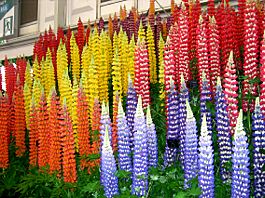

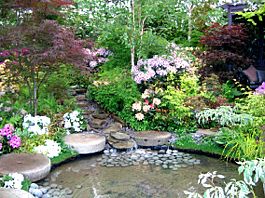
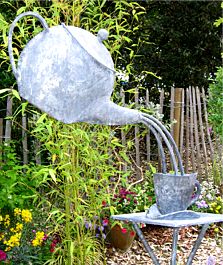
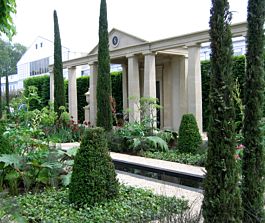 I
was at least rewarded by a garden sculpture for sale on an exhibitor's stand;
that of a pouring teapot! This whimsical sculpture was rather novel showing a
teapot in mid air pouring fourth the tea into a cup sat upon a small table. I
was also not surprised to see that the design features of classical architecture
had been used in the creation of some of the entrants garden designs, such as
this one with its classical pedimented temple with Cyprus conifer trees giving
the garden its upward structure.
I
was at least rewarded by a garden sculpture for sale on an exhibitor's stand;
that of a pouring teapot! This whimsical sculpture was rather novel showing a
teapot in mid air pouring fourth the tea into a cup sat upon a small table. I
was also not surprised to see that the design features of classical architecture
had been used in the creation of some of the entrants garden designs, such as
this one with its classical pedimented temple with Cyprus conifer trees giving
the garden its upward structure.
Chelsea flower show is certainly an event worth visiting, but my recommendation is maybe to take yourself a picnic with you or to take tea elsewhere!
To review past newsletters, just follow this link:
Past newsletters.
To subscribe to this free newsletter -
Click here